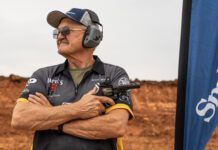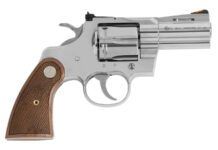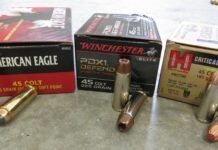The U.S. Ordnance Board has always invited side-arm manufactures to pit their designs against the competition to determine which firearms are best suited for combat. The Colt Single Action Army (SAA) seemed like a shoe-in after the Civil War because the Army liked the Colt Model 1860 percussion revolver. The Remington 1858 cap-and-ball revolver was also popular with the Army, but the days of loose powder and ball were ending. By 1870, technology had evolved, and Smith & Wesson had an edge, and Government orders. S&W sold the Army on the Model 3 revolver in 1870, which was the first self-contained metallic-cartridge-firing sidearm in U.S. service. Cartridges today are taken for granted, yet back then, cartridges were cutting-edge weaponry. The Army tweaked the Model 3 design and landed on a variant of the Model 3 called the Schofield revolver chambered in 45 S&W, also called 45 Schofield.
We decided to take a look at four modern replicas of single-action revolvers that were introduced between 1870 and 1875 and do our own abbreviated version of sidearm trials circa 1873. We looked for accuracy, point of aim, trigger weight, ease of use, and smooth actions.
Our entrants included a third-generation Colt SAA, which is descended from the original Colt SAAs used by the Army; an Uberti Outlaw Army, which is a replica of the Remington Model 1875; an Uberti 1873 No. 3 Top Break Model, which is a near clone of a Smith & Wesson No. 3 Schofield revolver and another revolver adopted by the Army; and finally a 21st-century newcomer from Taylor’s & Co. called the Drifter, which is similar to a traditional SAA revolver but with upgrades.
All of these revolvers are full size with either a 7- or 7.5-inch barrel. They all are chambered for 45 Colt, have fixed sights, six-round capacity, and are single action only. You need to cock the hammer then squeeze the trigger to make these old-timers go bang. The firing pin is built into the hammer, so the safest way to carry these revolvers is with the hammer resting on an empty chamber. The Schofield and Outlaw have a hammer-safety block that is activated when you cock the hammer back until you hear the first click. The Taylor’s uses Uberti’s retractable firing-pin safety system used in Uberti’s 1873 Cattleman II revolvers. The Colt uses late 19th-century technology that relies on the user’s common sense rather than a manual or built-in safety.
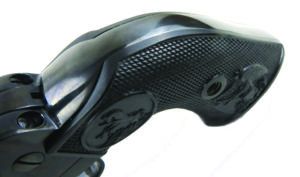
The Taylor’s, Colt, and Uberti Outlaw are similar in that they employ a right-side loading gate and ejector rod to load and unload the revolver one chamber at a time. The Uberti 1873 No. 3 is a top-break design that allows the user to flip a latch and rotate the barrel and cylinder away from the frame to eject all the empty shells at the same time. You can see right away that the Uberti/S&W Schofield has an edge with the ability to load and unload more rapidly than the other revolvers. With the other revolvers, the shooter loads and unloads one chamber at a time. Tedious at best, and we imagine nerve-racking when in a gunfight. While the Schofield has the advantage in loading and unloading, the original Schofield fired the 45 Schofield/45 S&W cartridge, which is shorter than the 45 Colt. The cartridge used a similar bullet weight as the 45 Colt, and on average, the velocity was 100 fps less. The 45 Schofield is also compatible with 45 Colt guns, so back in the day, the Army used the 45 Schofield cartridge in Colt SAA revolvers. Unfortunately, the 45 Colt could not be used in guns chambered for 45 Schofield. This was the downfall for the S&W Schofield revolver’s wider acceptance. The Army preferred the power of the 45 Colt cartridge, and the Army had plenty of 45 Colt ammo on hand, so the Schofield was dropped from the ranks. Luckily, Uberti’s modern take on the Schofield revolver chambers it in 45 Colt, so the Uberti is not an exact replica, but it is close enough for Government work.
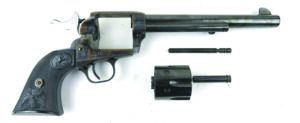
We decided to test both 45 Colt and 45 Schofield ammunition. For the 45 Schofield round, we used Choice Ammunition 200-grain RNFP (Round Nose Flat Point) lead Black Hi-Tek. The non-toxic Black Hi-Tek coating encapsulates the lead bullet, replacing standard dry lubricant. Hi-Tek coating has been used for years in other countries and shoots cleaner than bare lead. We can attest that the Choice Ammunition loads do shoot cleanly. This ammo is made in Montana. For 45 Colt rounds, we used a 250-grain RNFP Lead Hi-Tek Black from Choice Ammunition, a 255-grain RNFP from Hornady’s Cowboy line, and 250-grain LFN loads from Sellier & Bellot. Those cartridges rounded out the low-velocity cowboy-action-shooting-style loads. The modern 45 Colt load was a SIG V-Crown cartridge loaded with a 230-grain JHP bullet.
For accuracy testing we used our range bag as a rest and thumbed away at targets set at 15 yards. Our first impression was that some of the front-sight blades were thin and hard to see. We understand the adage “aim small, miss small,” but we needed to concentrate to be surgical with Outlaw and Schofield. All revolvers shot to point of aim, which can be a hurdle for some fixed-sight revolvers.
The triggers were the next characteristic that left an impression. The Colt had the worst trigger of the bunch, yet was the most expensive. The Taylor’s trigger and action were silky, and the Outlaw and Schofield started to smooth out after repeated firing.
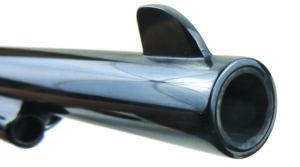
The third thing were the grips. The Colt and Taylor’s were typical SAAs with flat sides that flared out toward the bottom of the grip. We thought the Colt grips were toothy enough so the gun didn’t slip in our hand during recoil. The Taylor’s grip was smooth. The Outlaw had a fatter and rounded grip that filled our hands without it feeling too chunky. The Schofield grip was small, like a grip on a compact revolver.
For fast shooting, we used a Thompson Targets B27STOP Upper Torso Life Size Silhouette target ($7/5; ThompsonTarget.com), which features a T-shaped head and chest zone highlighted in bright red. We fired single hand and two handed, using our support hand to cock the revolvers. Two-handed hold dramatically increased speed. We pushed ourselves on speed and found we could get lead downrange fast and accurately when we aimed for center of mass. The head shots took a little more time and finesse.
All in, we had fun with these modern renditions of late 19th-century revolvers, and we appreciated the workmanship as well as mixing old technology with new. These may have been vintage pieces, but we never felt undergunned had we needed to use them for home defense. Here’s what else we discovered about these new-antique revolvers.
Gun Tests Grade: B
$1999
Out of the box, the Colt SAA looked sexy with a deeply blued barrel and cylinder and case-hardened frame. The black-polymer double eagle grips were well fitted, and the balance in hand is excellent. And it should be, since Colt has been making them since 1873. This is the “Peacemaker” used not only by lawmen and outlaws of the Old West, but the U.S. military. The Colt was the primary sidearm of the military between 1873 and 1892 spec’d out with a 7.5-inch barrel, chambered in 45 Colt, a less bright finish, and smooth wood grips, to name a few of the specifications. The U.S. Government paid about $12.50 for each revolver back then. Today the cost is nearly $2000. Commercial variants back then were slightly more expensive. Our sample was a 3rd Generation currently made by Colt. For you Colt SAA fans out there, our sample is a newer 3rd Generation with the cylinder bushing. Early 3rd Generation guns omitted the bushing.
| Action Type | Revolver, single action, hammer fired |
| Overall Length | 13.0 in. |
| Barrel Length | 7.5 in. |
| Barrel Twist Rate | 1:16 in. RH |
| Sight Radius | 8.5 in. |
| Overall Height | 5.5 in. |
| Maximum Width | 1.6 in. |
| Weight Unloaded | 40.8 oz. |
| Weight Loaded | 46.02 oz. |
| Cylinder Gap | 0.005 in. |
| Capacity | 6 |
| Frame Finish | Case hardened |
| Barrel/Cylinder Finish | Blued |
| Frame Front Strap Height | 2.1 in. |
| Frame Back Strap Height | 3.4 in. |
| Grip | Black composite w/double eagle logo |
| Grip Thickness (Maximum) | 1.5 in. |
| Grip Circumference (Maximum) | 6.0 in. |
| Front Sight | Fixed blade |
| Rear Sight | U-notch top strap |
| Hammer Cocking Effort | 7.5 lbs. |
| Trigger Pull Weight | 4.9 lbs. |
| Trigger Span | 2.8 in. |
| Safety | None |
| Warranty | 1 year |
| Telephone | (800) 962-2658 |
| Website | Colt.com |
| Made In | U.S.A. |
The Colt was not as slick to cock as the Taylor’s, but the four clicks to fully cock the revolver is music to some of our evaluators’ ears. It is the melodious sound of tradition and precision. The trigger pull, however, reminded us of finger nails dragged across a chalk board. It was heavy at nearly 5 pounds. We could barely stand it and found the heavy trigger pull eroded accuracy. It also took 7.5 pounds of effort to cock the hammer. The action smoothed up after repeated use.
While the Drifter averaged 1.95-inch groups across all ammo, the Colt averaged 2.07 inches, which was second best of all four revolvers. In our opinion, if the Colt had a better trigger, groups would shrink. The accuracy potential is there, just stymied by an inferior trigger pull. This may be heresy, but maybe Colt’s new owner, CZ, can work some Eastern European engineering magic and make the triggers coming out of Hartford crisper and lighter. Perhaps CZ might consider updating the design with a 4th Generation that includes a safety mechanism? Send emails to the editor, not me.
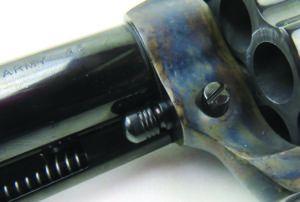
Loading was typical Colt SAA. Cock back the hammer to the second click, flick open the loading gate, and load each chamber. Load-one, skip-one is best practice because there are no safety mechanisms built in, except common sense. Best practice with SAA revolvers is to load one chamber, skip a chamber, and load the remaining chambers. This ensures the hammer rests on an empty chamber. In case of an accidental drop, the revolver won’t fire with the hammer resting on an empty chamber. Because we were shooting for accuracy and speed and not carrying the revolver, we loaded it full up with six cartridges.
Our best group measured 0.9 inches with Sellier & Bellot ammo loaded with a 250-grain RNFP bullet; average groups measured 1.31 inches. We thought the Colt was on its way to best the other revolvers in accuracy, but that was not the case. Our least-accurate ammo was Hornady Cowboy, which had a smallest group of 3.29 inches and averaged 3.22 inches. With the modern SIG defense load carrying a 230-grain JHP bullet, our best group measured 1.70 inches; average was 2.15 inches. With the 45 Schofield ammo, our best group measured 1.60 inches; average was 1.76 inches. The Colt exhibited good accuracy, but the trigger made pinpoint shooting difficult. We also noticed the front-sight blade was slightly thinner and the rear notch a smidge too small. We preferred the sights on the Drifter. The Colt had a 0.005-inch cylinder gap; hence, it gave the highest velocities of all guns tested. It eked out 912 fps with the modern SIG ammo.
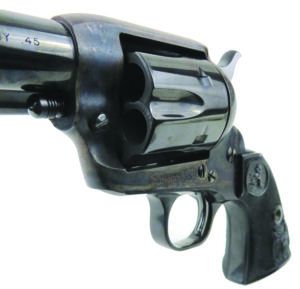
The Colt was the lightest gun, weighing 46 ounces fully loaded. We did not experience any uncomfortable recoil, though the SIG ammo was borderline, with sharp recoil. The checkered grip helped keep the revolver in our hand. The only way to shoot the Colt fast was using the thumb of our support hand. It also took a hair longer to cock the hammer, and that helped us concentrate on the front sight.
Most cases fell free from the chambers. We did need to use the ejector rod with the Sellier & Bellot and Hornady cases.
Our Team Said: The extra cost of the Colt Single Action Army revolver — more than three times as much as the Taylor’s Drifter handgun — should mean the Colt is better made and equipped. Sadly, it is not. However, an edge the Colt has over the Taylor’s is value. The value of the Colt revolver, new or used, will always be higher than any Italian SAA clone.
45 Colt Range Data
To collect accuracy data, we fired five-shot groups from a bench using a rest. Distance: 15 yards with open sights. We recorded velocities using a ProChrono DLX digital chronograph set 10 feet from the muzzle.| SIG V-Crown 230-grain JHP | Colt Single Action Army | Taylor’s & Co. Drifter | Uberti 1873 Top Break | Uberti Outlaw |
| Average Velocity | 912 fps | 784 fps | 846 fps | 750 fps |
| Muzzle Energy | 425 ft.-lbs. | 314 ft.-lbs. | 366 ft.-lbs. | 287 ft.-lbs. |
| Smallest Group | 1.70 in. | 2.41 in. | 2.13 in. | 1.57 in. |
| Average Group | 2.15 in. | 2.70 in. | 2.23 in. | 1.78 in. |
| Hornady Cowboy 255-grain RNFP | Colt Single Action Army | Taylor’s & Co. Drifter | Uberti 1873 Top Break | Uberti Outlaw |
| Average Velocity | 782 fps | 679 fps | 738 fps | 648 fps |
| Muzzle Energy | 346 ft.-lbs. | 261 ft.-lbs. | 308 ft.-lbs. | 238 ft.-lbs. |
| Smallest Group | 3.22 in. | 1.55 in. | 2.10 in. | 1.22 in. |
| Average Group | 3.29 in. | 1.91 in. | 2.36 in. | 1.26 in. |
| Sellier & Bellot 250-grain RNFP | Colt Single Action Army | Taylor’s & Co. Drifter | Uberti 1873 Top Break | Uberti Outlaw |
| Average Velocity | 890 fps | 843 fps | 809 fps | 808 fps |
| Muzzle Energy | 440 ft.-lbs. | 395 ft.-lbs. | 363 ft.-lbs. | 362 ft.-lbs. |
| Smallest Group | 0.95 in. | 2.53 in. | 1.82 in. | 2.88 in. |
| Average Group | 1.31 in. | 2.68 in. | 2.03 in. | 3.24 in. |
| Choice Ammunition 250-grain RNFP | Colt Single Action Army | Taylor’s & Co. Drifter | Uberti 1873 Top Break | Uberti Outlaw |
| Average Velocity | 888 fps | 823 fps | 846 fps | 788 fps |
| Muzzle Energy | 438 ft.-lbs. | 376 ft.-lbs. | 397 ft.-lbs. | 345 ft.-lbs. |
| Smallest Group | 1.71 in. | 2.02 in. | 1.10 in. | 1.87 in. |
| Average Group | 1.92 in. | 2.17 in. | 1.32 in. | 1.92 in. |
45 Schofield Range Data
To collect accuracy data, we fired five-shot groups from a bench using a rest. Distance: 15 yards with open sights. We recorded velocities using a ProChrono DLX digital chronograph set 10 feet from the muzzle.| Choice Ammunition 200-grain RNFP | Colt Single Action Army | Taylor’s & Co. Drifter | Uberti 1873 Top Break | Uberti Outlaw |
|---|---|---|---|---|
| Average Velocity | 883 fps | 839 fps | 839 fps | 822 fps |
| Muzzle Energy | 346 ft.-lbs. | 313 ft.-lbs. | 313 ft.-lbs. | 300 ft.-lbs. |
| Smallest Group | 1.60 in. | 1.64 in. | 1.80 in. | 2.75 in. |
| Average Group | 1.76 in. | 1.77 in. | 1.82 in. | 2.77 in. |


























